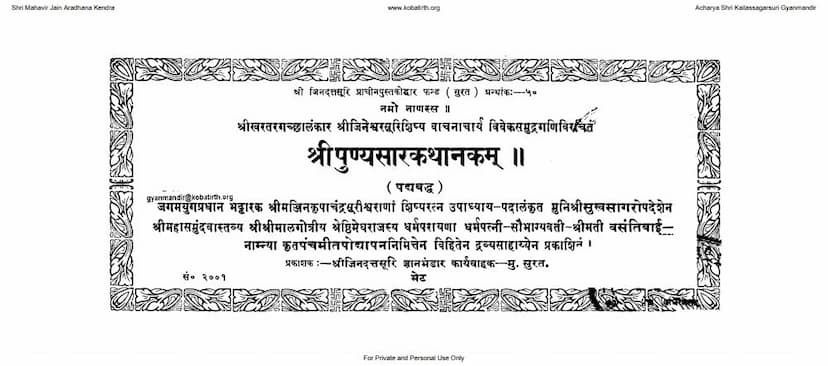Punyasara Kathanakam
Added to library: September 2, 2025

Summary
The book "Punyasara Kathanakam" (The Tale of Punyasara) authored by Vachanaacharya Viveksamudra Gani, a disciple of Shri Jineshwara Suri, is a Jain text that expounds on the virtues and fruits of Sadhrammik Vatsalya (compassionate love and care for fellow Jains). The text was composed in the year V.S. 1334 (1277 CE) and is presented in verse form.
Key Themes and Narrative:
The core message of the Punyasara Kathanakam revolves around the immense spiritual and material benefits derived from practicing Sadhrammik Vatsalya. The narrative illustrates this through the story of Dhanasara, a wealthy merchant, and his son, Punya-sara.
-
The Moral Dilemma and the Mother's Wisdom: The story begins with Dhanasara's son, Dharmasara, being advised by his mother about the importance of not consuming stale food, as it leads to suffering. Dharmasara, influenced by worldly pleasures and habits, disregards this advice. When he questions his mother's words, she directs him to a knowledgeable sage, Shrutsagar Sadhu, for clarification.
-
The Sage's Guidance and the Journey: The sage, understanding Dharmasara's confusion, directs him to a wise and virtuous person named Sthavara in the city of Saubagyapura. Dharmasara embarks on a journey to find Sthavara, and on his way, he witnesses the prosperity and beauty of Saubagyapura, which awakens his desire to seek spiritual knowledge.
-
The Encounter with Sthavara and the Lesson of True Wealth: In Saubagyapura, Dharmasara encounters Sthavara, who, despite his humble appearance, embodies the true spirit of Jainism. Sthavara reveals that while material wealth and worldly possessions are fleeting, true wealth lies in spiritual merit and compassion for fellow beings. He explains that the prosperity he witnesses is a result of his devotion to Jain principles.
-
Dhanasara's Greed and Misunderstanding: Meanwhile, Dhanasara, Dharmasara's father, is depicted as a miserly and greedy individual. He is obsessed with his wealth and does not want to spend it on religious activities or the welfare of his fellow Jains. This greed leads him to a tragic end, where he dies in extreme poverty despite his vast riches.
-
Punya-sara's Spiritual Awakening and the Role of Sthavara: Dharmasara, after his encounter with Sthavara, is deeply impacted by the teachings. He returns home and further engages with Sthavara, who eventually reveals that Dharmasara's past life was as Sthavara himself. This realization helps Dharmasara understand the cyclical nature of karma and the importance of virtuous actions.
-
The Birth and Upbringing of Punya-sara: In another part of the narrative, the birth of Punya-sara is described. His mother, a virtuous woman, names him Punya-sara, signifying the fruit of his past merits. Punya-sara is raised with profound spiritual values and a deep commitment to Jainism.
-
The Intervention of Shrutsagar Suri: The story highlights the role of spiritual guides like Shrutsagar Suri in shaping individuals' lives. Shrutsagar Suri plays a crucial role in guiding both Dharmasara and Punya-sara towards righteousness and spiritual realization.
-
The Ultimate Liberation: The narrative culminates with Punya-sara's unwavering devotion to Sadhrammik Vatsalya. He dedicates his life to the welfare of fellow Jains, practicing compassion, charity, and austerity. Through these virtuous actions, he achieves Kevalgyan (omniscience) and eventually attains Moksha (liberation).
Overall Message:
Punyasara Kathanakam emphasizes that:
- True prosperity is spiritual, not material.
- Compassionate love and care for fellow Jains (Sadhrammik Vatsalya) is a direct path to spiritual progress and liberation.
- Greed and attachment to worldly possessions lead to suffering and downfall.
- The guidance of enlightened spiritual masters is crucial for spiritual growth.
- Every action has a consequence (karma), and past merits pave the way for present and future happiness.
The text serves as a moral and spiritual guide, encouraging readers to cultivate virtues like compassion, generosity, and spiritual devotion to achieve lasting happiness and ultimate salvation.